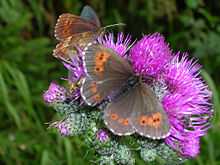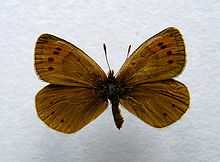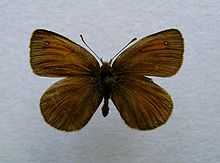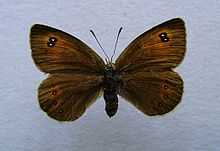Erebia
| Erebia | |
|---|---|
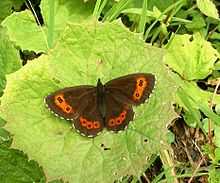 | |
| Arran brown (type species) | |
| Scientific classification | |
| Kingdom: | Animalia |
| Phylum: | Arthropoda |
| Class: | Insecta |
| Order: | Lepidoptera |
| Family: | Nymphalidae |
| Subfamily: | Satyrinae |
| Tribe: | Satyrini |
| Subtribe: | Erebiina |
| Genus: | Erebia Dalman, 1816 |
| Type species | |
| Papilio ligea Linnaeus, 1758 | |
| Diversity | |
| Around 100 species | |
| Synonyms | |
|
Atercoloratus Bang-Haas, 1938 | |
Erebia is a Holarctic genus of brush-footed butterflies, family Nymphalidae. Most of the about 90–100 species (see also below) are dark brown or black in color, with reddish brown to orange or more rarely yellowish wing blotches or bands. These usually bear black spots within, which sometimes have white center spots.
This genus has found it easy to adapt to arid and especially cold conditions. Most of its members are associated with high-altitude lands, forest clearings or high latitude and tundra. Erebia species are frequent in the Alps, Rocky Mountains, subarctic and even arctic regions, and the cooler parts of Central Asia. In fact, the North American term for these butterflies is "alpines". Eurasian species are collectively known as "ringlets" or "arguses". However, none of these terms is used exclusively for this genus.
Taxonomy and systematics
The genus Erebia was erected by Johan Wilhelm Dalman in 1816. As type species, the Arran brown—described as Papilio ligea by Linnaeus in 1758—was chosen. This is a very complex genus with over 1300 taxa, but a massive proportion of these are junior synonyms. Some of the available names are listed by Vladimir Lukhtanov.[1] A fully comprehensive taxonomic checklist (i.e., without discussing synonymy and relationships) was published in 2008.[2]
Only three years after the genus' inception, the known species were reviewed by Jacob Hübner.[3] He established no less than five new genera for a fraction of what would eventually be named as "species" of Erebia. But things hardly improved as more and more of the diversity of these butterflies came to note. In Europe, a large number of Erebia taxa was described from the Alps. In the 19th and early 20th century the Alps were a popular destination for butterfly collectors and specimens of Alpine butterflies were very profitable for dealers. The dealers, mostly German, not only sold specimens, but were entomologists, entomological book dealers, entomological authors and publishers. Examples are Fritz Rühl, Alexander Heyne, Otto Staudinger, Andreas and Otto Bang-Haas and, in Paris, Achille and Émile Deyrolle.
This, together with the then-popular, even obsessive study of variation by entomologists—examples are James William Tutt, George Wheeler, Felix Bryk and Brisbane Charles Somerville Warren—led to very many names being applied to what may be or much more likely may not be biological species or subspecies. A further problem is the use of the term "variety". Authors of that time used this for an individual variant, a group of individuals morphologically but not otherwise related, seasonal forms, temperature-related forms, or geographic races; it was later usually taken to mean the last subspecies though this is often suspected to have been premature.
Eventually, it became common to arrange supposed species and subspecies to "species groups" (not superspecies, but an informal phenetic arrangement) as pioneered by B.C.S. Warren,[4] and attempt to resolve their true nature by and by. As molecular phylogenetic studies add to the available data, it is becoming clear that most "varieties" that have at least been commonly considered subspecies in the latter 20th century are indeed lineages distinct enough to warrant some formal degree of recognition. Another result of recent research is confirmation of the theory that this genus contains many glacial relict taxa, e.g., in the "brassy ringlet" group (E. tyndarus and similar species).[5]
The number of currently recognized Erebia species is given variously around 90-100, as developments happen so fast that it is hard for authors to remain up to date regarding the newest changes.[5]
Species list
As of early 2008, the following good species and some rather distinct subspecies are listed:[6]
|
|
Gallery
-

First of the three Erebia plates in the 1915 Macrolepidoptera of the World, edited by Adalbert Seitz. This work was published near the height of taxonomic confusion about these butterflies.
-

Another Macrolepidoptera of the World plate, showing larger species
-
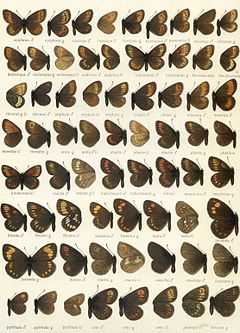
Third Macrolepidoptera of the World plate, of the 31 named taxa depicted, probably less than 10 are actual species
Erebia comparison
-

Erebia aethiops
-
.jpg)
Erebia aethiops
-

Erebia aethiops
underside ♂ -

Erebia aethiops
underside ♀ -
Erebia neoridas
-

Erebia meolans
-
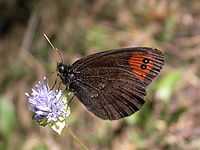
Erebia meolans
-

Erebia alberganus
underside -
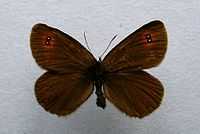
Erebia oeme ♂
-

Erebia oeme ♀
-

Erebia oeme
underside ♂ -

Erebia oeme
underside ♀ -
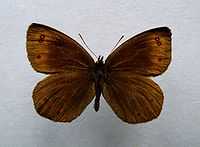
Erebia pronoe
-
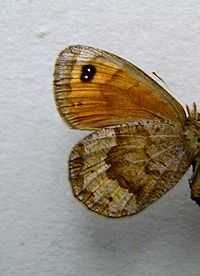
Erebia pronoe
underside ♀ -
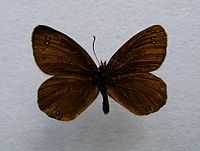
Erebia pluto
-
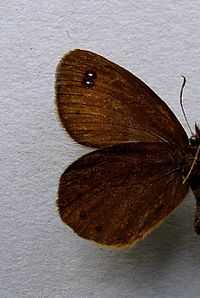
Erebia pluto
underside -
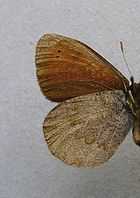
Erebia pandrose
underside -

Erebia stirius
-

Erebia stirius
underside -
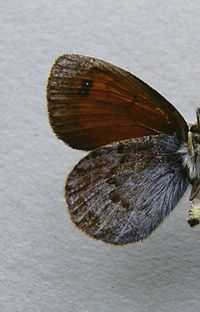
Erebia nivalis
underside -

Erebia manto ♂
-
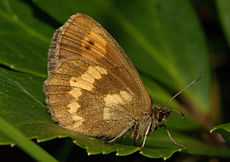
Erebia manto
underside ♀ -

Erebia gorge
-

Erebia gorge f. triopes
-

Erebia gorge f. erynis
-

Erebia gorge
underside -
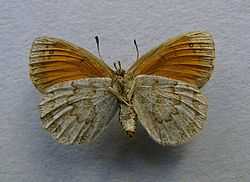
Erebia tyndarus
underside -
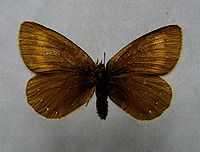
Erebia claudina
-

Erebia claudina
underside -
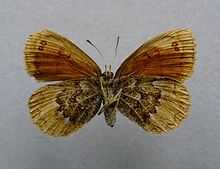
Erebia cassioides
underside ♀ -

Erebia pharte
underside -
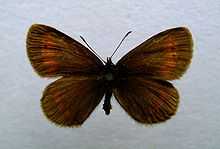
Erebia sudetica
-

Erebia mnestra
-

Erebia mnestra
underside -

Erebia christi
-
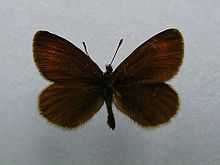
Erebia eryphile
-

Erebia zapateri
-

Erebia episodea
-
Erebia flavofasciata
-
Erebia gorgone
-
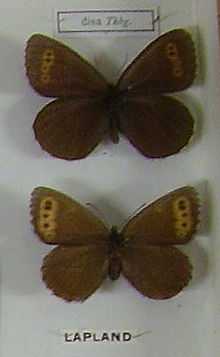
Erebia disa
-
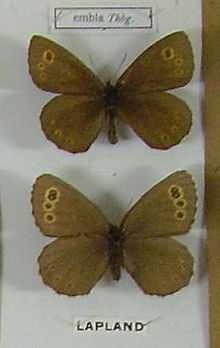
Erebia embla
See also
- Other Lepidoptera genera with excessive named taxa:
- Species concept
- Species problem
Footnotes
References
- Albre, Jerome; Gers, Charles & Legal, Luc (2008): Molecular phylogeny of the Erebia tyndarus (Lepidoptera, Rhopalocera, Nymphalidae, Satyrinae) species group combining CoxII and ND5 mitochondrial genes: A case study of a recent radiation. Mol. Phylogenet. Evol. 47(1): 196–210. doi:10.1016/j.ympev.2008.01.009 (HTML abstract)
- Brower, Andrew V.Z. (2006): Tree of Life Web Project - Erebia. Version of 2006-NOV-28. Retrieved 2008-AUG-11.
- Hübner, Jacob [1819]: [Several new genera for Erebia]. In: Verzeichniss bekannter Schmettlinge [sic] (Vol.4): 62-64.
- Lukhtanov, Vladimir [2008]: Palaearctic Butterfly Checklist - Nymphalidae: Satyrinae. Version of 2008-FEB-04. Retrieved 2008-AUG-11.
- Savela, Markku (2008): Markku Savela's Lepidoptera and some other life forms - Erebia. Version of 2008-MAR-15. Retrieved 2008-AUG-11.
- Tennent, W. John (2008): A checklist of the satyrine genus Erebia (Lepidoptera) (1758–2006). Zootaxa 1900: 1-109. PDF contents, abstract and first page text
- Warren, Brisbane Brisbane Charles Somerville (1936): Monograph of the genus Erebia. British Museum of Natural History, London.
External links
| Wikimedia Commons has media related to Erebia. |
| Wikispecies has information related to: Erebia |
- Nearctica Images of some Nearctic species.
- Nearctic species
- European species
- Rusinsects Former U.S.S.R. Erebia photographs, accurate text.
- Kulfan pdf Erebia fauna of the Tatras
- Zipcode Zoo
- Pdf from Nagy et al. Alpine Biodiversity in Europe (Arctic-Alpine Butterflies).
- Flickr images
.jpg)
